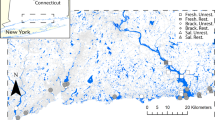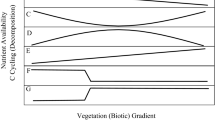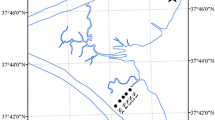Abstract
Wetland condition can be severely altered as a result of a change in hydrology. In this study, we examined several soil-based methods to quantify and assess changes in salt marsh condition as a result of tidal restriction. Soil properties were compared between two tidally restricted and two (paired) unrestricted salt marshes. Organic horizon morphology provided a qualitative metric of marsh peat decomposition. Quantitative measures of the degree of decomposition included stable plant fragment content and bearing capacity. Soil pH provided simple metrics of changes in soil chemistry. Bulk density was measured to estimate marsh peat collapse and soil organic matter content provided a measure of carbon dynamics. Neither marsh showed significant differences in soil organic matter or bulk density relative to their paired reference marsh. In contrast, soil pH, stable plant fragment content, and bearing capacity were significantly different between restricted and reference marshes. With the exception of incubation pH, these soil properties can be simply and rapidly measured in the field to quantify physical, chemical, and biological changes in the wetland condition of salt marshes as a result of tidal restriction. Further studies should be conducted to develop a rapid protocol for measuring incubation pH in the field.
Similar content being viewed by others
References
Anisfeld SC, Benoit G (1997) Impacts of flow restriction on salt marshes: an instance of acidification. Environmental Science and Technology 31:1650–1657
Bertness MD (1991) Zonation of Spartina patens and Spartina alterniflora in a New England salt marsh. Ecology 72:138–148
Bertness MD, Miller T (1984) The distribution and dynamics of Uca pugnax burrows in a New England salt marsh. Journal of Experimental Marine Biology and Ecology 83:211–237
Blake GR, Hartge K (1986) Bulk density. In: Klute A (ed) Methods of soil analysis, Part 1, 2nd edn. Agronomy Monograph 9, American Society of Agronomy, Soil Science Society of America, Madison, WI pp 363–375
Bradshaw JG (1991) A technique for the functional assessment of nontidal wetlands in the coastal plain of Virginia. Special Report No. 315. In: Applied Marine Science and Ocean Engineering. Virginia Institute of Marine Science, College of William and Mary, Gloucester Point, VA Available via DIALOG. http://ccrm.vims.edu/publications/pubs/VIMSMethodReportNo315.pdf Accessed 13 July 2011
Collins JN, Stein ED, Sutula M, Clark R, Fetscher AE, Grenier L, Grosso C, Wiskind A (2008) California rapid assessment method for wetlands, version 5.0.2. 151 pp Available via DIALOG. http://www.cramwetlands.org/documents/2008-09-30_CRAM%205.0.2.pdf Accessed 13 July 2011
Cornu CE, Sadro S (2002) Physical and functional responses to experimental marsh surface elevation manipulation in Coos Bay’s south slough. Society for Ecological Restoration 10:474–486
Craft CB (2001) Soil organic carbon, nitrogen, and phosphorus as indicators of recovery in restored Spartina marshes. Restoration Ecology 19:87–91
DeLaune RD, Nyman JA, Patrick WH Jr (1994) Peat collapse, ponding and wetland loss in a rapidly submerging coastal marsh. Journal of Coastal Research 10:1021–1030
Fennessy MS, Jacobs AD, Kentula ME (2004) Review of rapid methods for assessing wetland condition. U.S. Environmental Protection Agency, Washington, DC, USA. EPA/600/R-04/009
Fennessy MS, Jacobs AD, Kentula ME (2007) An evaluation of rapid methods for assessing the ecological conditions of wetlands. Wetlands 27:543–560
Herrick JE, Jones TL (2002) A dynamic cone penetrometer for measuring soil penetration resistance. Soil Science Society of America Journal 66:1320–1324
Howarth RW, Teal JM (1979) Sulfate reduction in a New England salt marsh. Limnology and Oceanography 24:999–1013
Innis SA, Naiman RJ, Elliott SR (2000) Indicators and assessment methods for measuring the ecological integrity of semi-aquatic terrestrial environments. Hydrobiologia 422:111–131
Larson JS, Mazzarese DB (1994) Rapid assessment of wetlands: history and application to management. In: Mitsch WJ (ed) Global wetlands. Elsevier Science, Amsterdam, pp 625–636
Lodge TE, Hillestad HO, Carney SW, Darling RB (1995) Wetland Quality Index (WQI): a method for determining compensatory mitigation requirements for ecologically impacted wetlands. Proceedings of the American Society of Civil Engineers South Florida Section. Miami, FL
Luther GW, Church TM, Scudlark JR, Cosman M (1986) Inorganic and organic sulfur cycling in salt marsh pore waters. Science 232:746–749
Mack JJ (2001) Ohio rapid assessment method for wetlands, version 5.0. Ohio EPA Technical Bulletin Wetland 2001-1-1. Ohio Environmental Protection Agency, Division of Surface Water, 401 Wetland Ecology Unit, Columbus, OH. Available via DIALOG. http://www.epa.state.oh.us/portals/35/401/oram50um_s.pdf. Accessed 13July 2011
Miller RE Jr, Gunsalus BE (1999) Wetland rapid assessment procedure. Natural Resource Management Division, Regulation Department, South Florida Water Management District, West Palm Beach, FL, USA, Technical Publication REG-001
Minnesota Board of Water and Soil Resources (2010) Minnesota routine assessment method for evaluating wetland functions, version 3.4. Minnesota Board of Water and Soil Resources, St. Paul, MN Available via DIALOG. http://www.bwsr.state.mn.us/wetlands/mnram/MNRAM_fulltext_9_2010.pdf Accessed 15 March 2011
Nelson DW, Sommers LE (1965) Total carbon, organic carbon, and organic matter. In: Page AL, Miller RH, Keeney DR (ed) Methods of soil analysis, Part 2, 2nd edn. Agronomy Monographs 9, Agronomy Society of America and Soil Science Society of America, Madison, WI pp 539–580
Nestlerode JA, Engle VD, Bourgeois P, Heitmuller PT, Macauley JM, Allen YC (2009) An integrated approach to assess broad-scale condition of coastal wetlands—the Gulf of Mexico Coastal Wetlands pilot survey. Environmental Monitoring and Assessment 150:21–29
O’Shay T, Hossner LR, Dixon JB (1990) A modified hydrogen peroxide oxidation method for determination of potential acidity in pyritic overburden. Journal of Environmental Quality 19:778–782
Portnoy JW (1999) Salt marsh diking and restoration: biogeochemical implications of altered wetland hydrology. Environmental Management 24:111–120
Portnoy JW, Giblin AE (1997a) Effects of historic tidal restrictions on salt marsh sediment chemistry. Biogeochemistry 36:275–303
Portnoy JW, Giblin AE (1997b) Biogeochemical effects of seawater restoration to diked salt marshes. Ecological Applications 7:1054–1063
Redfield AC (1972) Development of a New England salt marsh. Ecological Monographs 42:201–237
Soil Survey Laboratory Staff (2004) Soil survey laboratory methods manual. United States Department of Agriculture, Government Printing Office, Washington, DC
Soil Survey Staff (1999) Soil taxonomy: a basic system of soil classification for making and interpreting soil surveys, 2nd edn. USDA-NRCS Agricultural Handbook 436, US Government Printing Office, Washington, DC
Soil Survey Staff (2006) Keys to soil taxonomy, 10th edn. USDA-NRCS, U.S. Government Printing Office, Washington, DC
Twohig T (2005) Assessing soil dynamics relative to salt marsh restoration efforts in New England. Thesis, University of Rhode Island
Van Dam RA, Camilleri C, Finlayson CM (1998) The potential of rapid assessment techniques as early warning indicators of wetland degradation: a review. Environmental Toxicology and Water Quality 13:297–312
Wardrop DH, Kentula ME, Stevens DL Jr, Jensen SF, Brooks RP (2007) Assessment of wetland condition: an example from the upper Juniata watershed in Pennsylvania, USA. Wetlands 27:416–431
Zar JH (1999) Biostatistical analysis, 4th edn. Prentice Hall, NJ
Author information
Authors and Affiliations
Corresponding author
Rights and permissions
About this article
Cite this article
Twohig, T.M., Stolt, M.H. Soils-Based Rapid Assessment for Quantifying Changes in Salt Marsh Condition as a Result of Hydrologic Alteration. Wetlands 31, 955–963 (2011). https://doi.org/10.1007/s13157-011-0210-7
Received:
Accepted:
Published:
Issue Date:
DOI: https://doi.org/10.1007/s13157-011-0210-7




